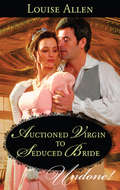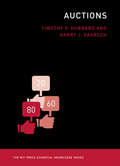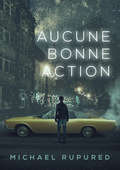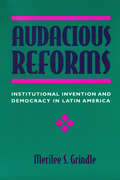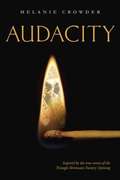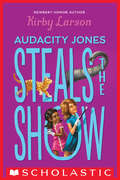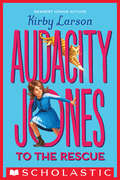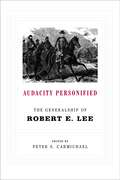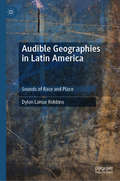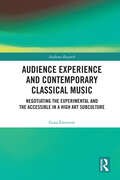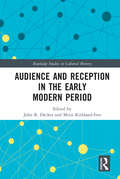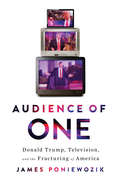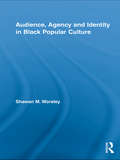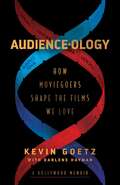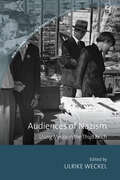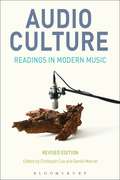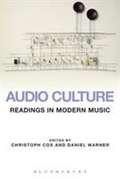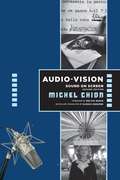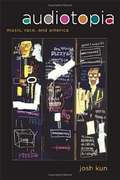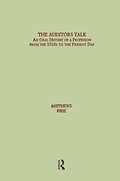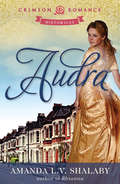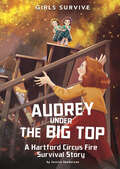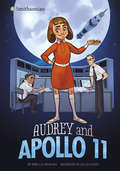- Table View
- List View
Auctioned Virgin to Seduced Bride
by Louise AllenLondon, 1814 Innocent Laurel Vernon is living a nightmare after being kidnapped and put up for auction in one of London's most notorious brothels. Only the memory of private enquiry agent Patrick Jago gives her strength. Even though she only knew him for a few days, Patrick made her feel both protected and weak with desire. When Laurel sees Patrick among the brothel's clientele, she isn't sure if he has come to rescue her or to satisfy his own lust. But she is certain that he intends to bid on her!
Auctions: The Mit Press Essential Knowledge Series (The MIT Press Essential Knowledge series)
by Timothy P. Hubbard Harry J. PaarschHow auctions work, in theory and practice, with clear explanations and real-world examples that range from government procurement to eBay.Although it is among the oldest of market institutions, the auction is ubiquitous in today's economy, used for everything from government procurement to selling advertising on the Internet to course assignment at MIT's Sloan School. And yet beyond the small number of economists who specialize in the subject, few people understand how auctions really work. This concise, accessible, and engaging book explains both the theory and the practice of auctions. It describes the main auction formats and pricing rules, develops a simple model to explain bidder behavior, and provides a range of real-world examples.The authors explain what constitutes an auction and how auctions can be modeled as games of asymmetric information—that is, games in which some players know something that other players do not. They characterize behavior in these strategic situations and maintain a focus on the real world by illustrating their discussions with examples that include not just auctions held by eBay and Sotheby's, but those used by Google, the U.S. Treasury, TaskRabbit, and charities. Readers will begin to understand how economists model auctions and how the rules of the auction shape bidder incentives. They will appreciate the role auctions play in our modern economy and understand why these selling mechanisms are so resilient.
Aucune bonne action (Les aventures de Philip Potter #2)
by Michael Rupured Julianne NovaLes aventures de Philip Potter, numéro hors sérieLa veille de Noël, en 1966, Philip Potter, un conservateur du Smithsonian au grand cœur, termine ses achats de dernière minute. Au même instant, James, son compagnon depuis plusieurs années, s’ôte la vie chez eux. Inconscient de ce qui l’attend, Philip dépose des cadeaux à un refuge pour sans-abris, un acte généreux qui fera plus tard de lui un suspect dans le meurtre d’un prostitué. Après la mort choquante de James, deux hommes entrent dans la vie de Philip… et tous deux conduisent une Continental jaune. L’un d’eux, toutefois, est un tueur avec le sang de six prostitués sur les mains. Et tous deux cachent quelque chose. Comme Philip est sur le point de le découvrir, aucune bonne action ne reste impunie.
Audacious Reforms: Institutional Invention and Democracy in Latin America
by Merilee S. GrindleAudacious Reforms examines the creation of new political institutions in three Latin American countries: direct elections for governors and mayors in Venezuela, radical municipalization in Bolivia, and direct election of the mayor of Buenos Aires in Argentina. Diverging from the usual incremental processes of political change, these cases marked a significant departure from traditional centralized governments. Such "audacious reforms," explains Merilee S. Grindle, reinvent the ways in which public problems are manifested and resolved, the ways in which political actors calculate the costs and benefits of their activities, and the ways in which social groups relate to the political process.Grindle considers three central questions: Why would rational politicians choose to give up power? What accounts for the selection of some institutions rather than others? And how does the introduction of new institutions alter the nature of political actions? The case studies of Venezuela, Bolivia, and Argentina demonstrate that institutional invention must be understood from theoretical perspectives that stretch beyond immediate concerns about electoral gains and political support building. Broader theoretical perspectives on the definition of nation and state, the nature of political contests, the legitimacy of political systems, and the role of elites all must be considered. While past conflicts are not erased by reforms, in the new order there is often greater potential for more responsible, accountable, and democratic government.
Audacity
by Melanie CrowderThe inspiring story of Clara Lemlich, whose fight for equal rights led to the largest strike by women in American history A gorgeously told novel in verse written with intimacy and power, Audacity is inspired by the real-life story of Clara Lemlich, a spirited young woman who emigrated from Russia to New York at the turn of the twentieth century and fought tenaciously for equal rights. Bucking the norms of both her traditional Jewish family and societal conventions, Clara refuses to accept substandard working conditions in the factories on Manhattan's Lower East Side. For years, Clara devotes herself to the labor fight, speaking up for those who suffer in silence. In time, Clara convinces the women in the factories to strike, organize, and unionize, culminating in the famous Uprising of the 20,000.Powerful, breathtaking, and inspiring, Audacity is the story of a remarkable young woman, whose passion and selfless devotion to her cause changed the world. Praise for AUDACITY: * "Crowder breathes life into a world long past....Compelling, powerful and unforgettable." --Kirkus Reviews, starred review * "This book stands alone....an impactful addition to any historical fiction collection."--School Library Journal, starred review* "With a thorough historical note, glossary of terms, and bibliography, this will make an excellent complement to units on women's rights and the labor movement, but it will also satisfy readers in search of a well-told tale of a fierce heroine."--BCCB, starred review* "This is an excellent title that can open discussions in U.S. history and economics courses about women's rights, labor unions, and the immigrant experience."--School Library Connection, starred review "Based on the true story of Clara Lemlich, Audacity throbs with the emotions of this exceptional young woman who fought for equal rights and improved labor standards in factories. Melanie Crowder's verses spit out Clara's rage, cradle her longing and soar like the birds that are her constant companions."--Bookpage "Crowder's (Parched) use of free verse in this fictionalization of Russian-Jewish immigrant Clara Lemlich's life brings a spare poignancy to a familiar history."--Publishers Weekly "Audacity is an evocative reimagining of a fascinating historical figure who should be remembered for her determination in the face of great odds and powerful opposition--and for her role in changing America. Melanie Crowder's powerful verse reveals a long-past world, but the combination of hope and outrage that Clara Lemlich brought to her struggle should be both recognizable and inspirational to teen readers longing to right the injustices of our day."--Margaret Peterson Haddix, critically acclaimed, bestselling author of UprisingFrom the Hardcover edition.
Audacity Jones Steals the Show (Audacity Jones #2)
by Kirby LarsonThe plucky and adventurous Audacity Jones returns for a brand new adventure in New York City, by Newbery Honor author Kirby Larson.Audacity Jones and her best friend, Bimmy, are setting off from Miss Maisie's School for Wayward Girls on an extraordinary adventure! In the glittering city of New York, the girls meet Harry Houdini, the world's most famous magician, as he prepares a new spectacle: Houdini plans to make an elephant disappear from a crowded theater.But Audacity and Bimmy discover a nefarious plot that puts Houdini's illusion in jeopardy. Who could be trying to sabotage the master magician? Audie will need all her smarts, the help of friends new and old, and even her best juggling skills to solve this mystery. Will she manage to save the show in time?Newbery Honor author Kirby Larson brings readers a magical romp of a mystery that will delight and thrill to the very last page.
Audacity Jones to the Rescue (Audacity Jones #1)
by Kirby LarsonAn irrepressible orphan named Audacity Jones is headed on an adventure of historic proportions! The first book in a brand-new series from beloved Newbery Honor author Kirby Larson!Audacity Jones is an eleven-year-old orphan who aches for adventure, a challenge to break up the monotony of her life at Miss Maisie's School for Wayward Girls. Life as a wayward girl isn't so bad; Audie has the best of friends, a clever cat companion, and plenty of books to read. Still, she longs for some excitement, like the characters in the novels she so loves encounter.So when the mysterious Commodore Crutchfield visits the school and whisks Audie off to Washington, DC, she knows she's in for the journey of a lifetime. But soon, it becomes clear that the Commodore has unsavory plans for Audie -- plans that involve the president of the United States and a sinister kidnapping plot. Before she knows it, Audie winds up in the White House kitchens, where she's determined to stop the Commodore dead in his tracks. Can Audie save the day before it's too late?
Audacity Personified: The Generalship of Robert E. Lee
by Peter S. CarmichaelDespite the literary outpouring on the life of Robert E. Lee, the southern chieftain remains an enigma. The existing scholarship is so voluminous, complex, and contradictory that it is difficult to penetrate the inner Lee and appreciate him as a general. Peter S. Carmichael has assembled a formidable array of Civil War historians who rigorously return to Lee's own words and actions in interpreting the war in Virginia. This is the first collective volume to scrutinize specific aspects of the general's military career.Carmichael's opening contribution confronts Lee's supposed drive for a victory of annihilation and takes issue with claims that he was too aggressive. William J. Miller's novel analysis of Lee's leadership during the pivotal Seven Days battles reconstructs his strategic thinking and corrects old assumptions. Gordon C. Rhea overturns the common notion that Lee anticipated his adversaries with uncanny precision in the Overland campaign of 1864. Robert E. L. Krick takes aim at the oft-repeated criticism that Lee was not attuned to the demands of modern warfare because he failed to surround himself with enough subordinates to ensure the smooth operation of the army; in fact, Krick argues, Lee continually fine-tuned the performance of his support staff, striving to eliminate deficiencies. Finally, Max R. Williams's examination of the relationship between Lee and North Carolina governor Zebulon B. Vance, and Mark L. Bradley's portrait of Lee's relationships with Jefferson Davis and Joseph E. Johnston, offer contrasting views of the soldier as both politically assertive and reticent, respectively. Falling easily into neither the pro- nor anti-Lee camp, Audacity Personified challenges long-standing beliefs accepted since Douglas Southhall Freeman's influential biography of Lee was published seventy years ago. These diverse scholarly visions of the great Confederate general move beyond cliché, iluuminating Lee's career with fresh interpretations.
Audible Geographies in Latin America: Sounds of Race and Place
by Dylon Lamar RobbinsAudible Geographies in Latin America examines the audibility of place as a racialized phenomenon. It argues that place is not just a geographical or political notion, but also a sensorial one, shaped by the specific profile of the senses engaged through different media. Through a series of cases, the book examines racialized listening criteria and practices in the formation of ideas about place at exemplary moments between the 1890s and the 1960s. Through a discussion of Louis Moreau Gottschalk’s last concerts in Rio de Janeiro, and a contemporary sound installation involving telegraphs by Otávio Schipper and Sérgio Krakowski, Chapter 1 proposes a link between a sensorial economy and a political economy for which the racialized and commodified body serves as an essential feature of its operation. Chapter 2 analyzes resonance as a racialized concept through an examination of phonograph demonstrations in Rio de Janeiro and research on dancing manias and hypnosis in Salvador da Bahia in the 1890s. Chapter 3 studies voice and speech as racialized movements, informed by criminology and the proscriptive norms defining “white” Spanish in Cuba. Chapter 4 unpacks conflicting listening criteria for an optics of blackness in “national” sounds, developed according to a gendered set of premises that moved freely between diaspora and empire, national territory and the fraught politics of recorded versus performed music in the early 1930s. Chapter 5, in the context of Cuban Revolutionary cinema of the 1960s, explores the different facets of noise—both as a racialized and socially relevant sense of sound and as a feature and consequence of different reproduction and transmission technologies. Overall, the book argues that these and related instances reveal how sound and listening have played more prominent roles than previously acknowledged in place-making in the specific multi-ethnic, colonial contexts characterized by diasporic populations in Latin America and the Caribbean.
Audience Experience and Contemporary Classical Music: Negotiating the Experimental and the Accessible in a High Art Subculture (Audience Research)
by Gina EmersonThis book responds to recent debates on cultural participation and the relevance of music composed today with the first large-scale audience experience study on contemporary classical music. Through analysing how existing audience members experience live contemporary classical music, this book seeks to make data-informed contributions to future discussions on audience diversity and accessibility. The author takes a multidimensional view of audience experience, looking at how sociodemographic factors and the frames of social context and concert format shape aesthetic responses and experiences in the concert hall. The book presents quantitative and qualitative audience data collected at twelve concerts in ten different European countries, analysing general trends alongside case studies. It also offers the first large-scale comparisons between the concert experiences and tastes of contemporary classical and classical music audiences. Contemporary classical music is critically discussed as a ‘high art subculture’ rife with contradictions and conflicts around its cultural value. This book sheds light on how audiences negotiate the tensions between experimentalism and accessibility that currently define this genre. It provides insights relevant to academics from audience research in the performing arts and from musicology, as well as to institutions, practitioners and artists.
Audience and Reception in the Early Modern Period (Routledge Studies in Cultural History #109)
by John R. DeckerEarly modern audiences, readerships, and viewerships were not homogenous. Differences in status, education, language, wealth, and experience (to name only a few variables) could influence how a group of people, or a particular person, received and made sense of sermons, public proclamations, dramatic and musical performances, images, objects, and spaces. The ways in which each of these were framed and executed could have a serious impact on their relevance and effectiveness. The chapters in this volume explore the ways in which authors, poets, artists, preachers, theologians, playwrights, and performers took account of and encoded pluriform potential audiences, readers, and viewers in their works, and how these varied parties encountered and responded to these works. The contributors here investigate these complex interactions through a variety of critical and methodological lenses.
Audience of One: Donald Trump, Television And The Fracturing Of America
by James PoniewozikOne of the Top 10 Politics and Current Events Books of Fall 2019 (Publishers Weekly) An incisive cultural history that captures a fractious nation through the prism of television and the rattled mind of a celebrity president. Television has entertained America, television has ensorcelled America, and with the election of Donald J. Trump, television has conquered America. In Audience of One, New York Times chief television critic James Poniewozik traces the history of TV and mass media from the Reagan era to today, explaining how a volcanic, camera-hogging antihero merged with America’s most powerful medium to become our forty-fifth president. In the tradition of Neil Postman’s masterpiece Amusing Ourselves to Death, Audience of One shows how American media have shaped American society and politics, by interweaving two crucial stories. The first story follows the evolution of television from the three-network era of the 20th century, which joined millions of Americans in a shared monoculture, into today’s zillion-channel, Internet-atomized universe, which sliced and diced them into fractious, alienated subcultures. The second story is a cultural critique of Donald Trump, the chameleonic celebrity who courted fame, achieved a mind-meld with the media beast, and rode it to ultimate power. Braiding together these disparate threads, Poniewozik combines a cultural history of modern America with a revelatory portrait of the most public American who has ever lived. Reaching back to the 1940s, when Trump and commercial television were born, Poniewozik illustrates how Donald became “a character that wrote itself, a brand mascot that jumped off the cereal box and entered the world, a simulacrum that replaced the thing it represented.” Viscerally attuned to the media, Trump shape-shifted into a boastful tabloid playboy in the 1980s; a self-parodic sitcom fixture in the 1990s; a reality-TV “You’re Fired” machine in the 2000s; and finally, the biggest role of his career, a Fox News–obsessed, Twitter-mad, culture-warring demagogue in the White House. Poniewozik deconstructs the chaotic Age of Trump as the 24-hour TV production that it is, decoding an era when politics has become pop culture, and vice versa. Trenchant and often slyly hilarious, Audience of One is a penetrating and sobering review of the raucous, raging, farcical reality show—performed for the benefit of an insomniac, cable-news-junkie “audience of one”—that we all came to live in, whether we liked it or not.
Audience, Agency and Identity in Black Popular Culture (Studies in African American History and Culture)
by Shawan M. WorsleyAudience, Agency and Identity in Black Popular Culture analyses black cultural representations that appropriate anti-black stereotypes. Using examples from literature, media, and art, Worsley examines how these cultural products do not rework anti-black stereotypes into seemingly positive images. Rather, they present anti-black stereotypes in their original forms and encourage audiences not to ignore, but to explore them. Shifting critical commentary from a need to censor these questionable images, Worsley offers a complex consideration of the value of and problems with these alternative anti-racist strategies in light of stereotypes’ persistence. This book furthers our understanding of the historical circumstances that are influencing contemporary representations of black subjects that are purposefully derogatory and documents the consequences of these images.
Audience-ology: How Moviegoers Shape the Films We Love
by Kevin GoetzDiscover the fascinating and secretive process of audience testing of Hollywood movies through these first-hand stories from famous filmmakers, studio heads, and stars.Audience-ology takes you to one of the most unknown places in Hollywood—a place where famous directors are reduced to tears and multi-millionaire actors to fits of rage. A place where dreams are made and fortunes are lost. This book is the chronicle of how real people have written and rewritten America&’s cinematic masterpieces by showing up, watching a rough cut of a new film, and giving their unfettered opinions so that directors and studios can salvage their blunders, or better yet, turn their movies into all-time classics. Each chapter informs an aspect or two of the test-screening process and then, through behind-the-scenes stories, illustrates how that particular aspect was carried out. Nicknamed &“the doctor of audience-ology,&” Kevin Goetz shares how he helped filmmakers and movie execs confront the misses and how he recommended ways to fix the blockbusters, as well as first-hand accounts from Ron Howard, Cameron Crowe, Ed Zwick, Renny Harlin, Jason Blum, and other Hollywood luminaries who brought you such films as La La Land, Chicago, Titanic, Wedding Crashers, Jaws, and Forrest Gump. Audience-ology explores one of the most important (and most underrated) steps in the filmmaking process with enough humor, drama, and surprise to entertain those with only a spectator&’s interest in film, offering us a new look at movie history.
Audiences of Nazism: Using Media in the Third Reich (New German Historical Perspectives #13)
by Ulrike WeckelThrough its focus on audiences and their reception of media in Nazi Germany, Audiences of Nazism inverts the typical top-down perspective employed in studies that concentrate on the regime’s regulation of media and propaganda. It thereby sheds new light on the complex character of the period’s media, their uses, and the scope for audience interpretation. Contributors investigate how consumers either appropriated or ignored certain messages of Nazi propaganda, and how some even participated in its production. The authors ground their studies on novel historical sources, including private diaries and letters, photographs and films, and concert programs, which demonstrate, amongst other things, how audiences interpreted and responded to regulated news, Nazi Party rallies, and the regime’s denunciation of modern works of art as ‘degenerate.’
Audio Culture, Revised Edition: Readings in Modern Music
by Christoph Cox Daniel WarnerThis new and expanded edition of the Audio Culture contains twenty-five additional essays, including four newly-commissioned pieces. Taken as a whole, the book explores the interconnections among such forms as minimalism, indeterminacy, musique concrète, free improvisation, experimental music, avant-rock, dub reggae, ambient music, hip hop, and techno via writings by philosophers, cultural theorists, and composers. Instead of focusing on some "crossover" between "high art" and "popular culture," Audio Culture takes all these musics as experimental practices on par with, and linked to, one another. Rather than offering a history of contemporary music, Audio Culture traces the genealogy of current musical practices and theoretical concerns, drawing lines of connection between recent musical production and earlier moments of sonic experimentation. The text includes writing by some of the most important musical thinkers of the past half-century, among them John Cage, Brian Eno, Ornette Coleman, Pauline Oliveros, Maryanne Amacher, Glenn Gould, Umberto Eco, Jacques Attali, Simon Reynolds, Eliane Radigue, David Toop, John Zorn, Karlheinz Stockhausen, and many others.
Audio Culture: Readings in Modern Music
by Christoph Cox Daniel WarnerThe groundbreaking Audio Culture: Readings in Modern Music maps the aural and discursive terrain of vanguard music today. Rather than offering a history of contemporary music, Audio Culture traces the genealogy of current musical practices and theoretical concerns, drawing lines of connection between recent musical production and earlier moments of sonic experimentation. It aims to foreground the various rewirings of musical composition and performance that have taken place in the past few decades and to provide a critical and theoretical language for this new audio culture. Via writings by philosophers, cultural theorists, and composers, Audio Culture explores the interconnections among such forms as minimalism, indeterminacy, musique concrète, free improvisation, experimental music, avant-rock, dub reggae, Ambient music, HipHop, and Techno. Instead of focusing on the putative "crossover" between "high art" and "popular culture," Audio Culture takes all of these musics as experimental practices on par with, and linked to, one another. While cultural studies has tended to look at music (primarily popular music) from a sociological perspective, the concern here is philosophical, musical, and historical. Audio Culture includes writing by some of the most important musical thinkers of the past half-century, among them John Cage, Brian Eno, Glenn Gould, Umberto Eco, Ornette Coleman, Jacques Attali, Simon Reynolds, Pauline Oliveros, Paul D. Miller, David Toop, John Zorn, Karlheinz Stockhausen, and many others. The book is divided into nine thematically-organized sections, each with its own introduction. Section headings include topics such as "Modes of Listening," "Minimalisms," and "DJ Culture. " In addition, each essay has its own short introduction, helping the reader to place the essay within musical, historical, and conceptual contexts. The book concludes with a glossary, a timeline, and an extensive discography.
Audio-Vision: Sound On Screen
by Michel ChionMichel Chion’s landmark Audio-Vision has exerted significant influence on our understanding of sound-image relations since its original publication in 1994. Chion argues that sound film qualitatively produces a new form of perception. Sound in audiovisual media does not merely complement images. Instead, the two channels together engage audio-vision, a special mode of perception that transforms both seeing and hearing. We don’t see images and hear sounds separately—we audio-view a trans-sensory whole.In this updated and expanded edition, Chion considers many additional examples from recent world cinema and formulates new questions for the contemporary media environment. He takes into account the evolving role of audio-vision in different theatrical environments, considering its significance for music videos, video art, commercial television, and the internet, as well as conventional cinema. Chion explores how multitrack digital sound enables astonishing detail, extending the space of the action and changing practices of scene construction. He demonstrates that speech is central to film and television and shows why “audio-logo-visual” is a more accurate term than “audiovisual.” Audio-Vision shows us that sound is driving the creation of a sensory cinema.This edition includes a glossary of terms, a chronology of several hundred significant films, and the original foreword by sound designer, editor, and Oscar honoree Walter Murch.
Audiotopia: Music, Race, and America
by Josh KunRanging from Los Angeles to Havana to the Bronx to the U.S.-Mexico border and from klezmer to hip hop to Latin rock, this groundbreaking book injects popular music into contemporary debates over American identity. Josh Kun insists that America is not a single chorus of many voices folded into one, but rather various republics of sound that represent multiple stories of racial and ethnic difference. To this end he covers a range of music and listeners to evoke the ways that popular sounds have expanded our idea of American culture and American identity. Artists as diverse as The Weavers, Cafe; Tacuba, Mickey Katz, Rahsaan Roland Kirk, Bessie Smith, and Ozomatli reveal that the song of America is endlessly hybrid, heterogeneous, and enriching--a source of comfort and strength for populations who have been taught that their lives do not matter. Kun melds studies of individual musicians with studies of painters such as Jean-Michel Basquiat and of writers such as Walt Whitman, James Baldwin, and Langston Hughes. There is no history of race in the Americas that is not a history of popular music, Kun claims. Inviting readers to listen closely and critically, Audiotopia forges a new understanding of sound that will stoke debates about music, race, identity, and culture for many years to come.
Auditor's Talk: An Oral History of the Profession from the 1920s to the Present Day (New Works In Accounting History Ser.)
by Derek Matthews Jim PirieThis book is an oral history of the auditing profession in Britain from 1920s to the present day based on extended extracts from interviews with 77 past and present practitioners. Those interviewed ranged from a nonagenarian who qualified in the 1920s, to active contemporaries, from sole practitioners to the present day heads of the Big Five accounting firms. The often candid interviews uncover a surprising variety of experience and opinions and allow a group of often fascinating individuals to tell their own stories.
Audra
by Amanda L.V. ShalabyAudra Kingsley, a wealthy heiress, may not have seen much of the world, but she knows exactly how she wants her future to play out - and a coming out ball held at her country estate, Kingsley Manor, would suit her just fine. Her father's wish that she be presented at St. James in London seems silly since she is to marry her neighbor and childhood sweetheart, Lord Crispin Brighton, but she obliges him.Audra travels to London with her patroness, the eccentric Lady Sutherland, intending to return home as soon as she has curtseyed to the Queen. Unknown to her, Lady Sutherland is in no rush to leave London before the Season is over and intends to show Audra she has more options in the suitor department than Lord Crispin, a second son.Audra finds herself surrounded by few friends and is forced to attend parties, balls, and operas - all while becoming the object of a secret admirer's obsession. As Audra struggles to make her way home to her beloved, plans to compromise her into an unwanted marriage are underway.Sensuality Level: Behind Closed Doors
Audra
by Amanda L.V. ShalabyAudra Kingsley, a wealthy heiress, may not have seen much of the world, but she knows exactly how she wants her future to play out - and a coming out ball held at her country estate, Kingsley Manor, would suit her just fine. Her father's wish that she be presented at St. James in London seems silly since she is to marry her neighbor and childhood sweetheart, Lord Crispin Brighton, but she obliges him.Audra travels to London with her patroness, the eccentric Lady Sutherland, intending to return home as soon as she has curtseyed to the Queen. Unknown to her, Lady Sutherland is in no rush to leave London before the Season is over and intends to show Audra she has more options in the suitor department than Lord Crispin, a second son.Audra finds herself surrounded by few friends and is forced to attend parties, balls, and operas - all while becoming the object of a secret admirer's obsession. As Audra struggles to make her way home to her beloved, plans to compromise her into an unwanted marriage are underway.Sensuality Level: Behind Closed Doors
Audrey Hepburn: A Photographic Celebration
by Suzanne Lander"I never understood what makes me so special," mused Audrey Hepburn. The daughter of a Dutch baroness, Hepburn first won international acclaim with her role as a princess in the 1953 film Roman Holiday, and she maintained a rare grace and elegance throughout her life that millions have adored and tried to emulate. Audrey Hepburn: A Photographic Celebration showcases the film star, who also worked as a UNICEF goodwill ambassador. This book is packed with great quotes from the woman herself and those who admire her (including Hollywood directors and movie stars) as well as engaging trivia and beautiful images of Audrey in all phases of her career. "I've been in pictures over thirty years, but I've never had a more exciting leading lady than Audrey," enthused Gary Cooper, her Love in the Afternoon costar. Audrey Hepburn: A Photographic Celebration features everybody's favorite leading lady with her leading men, including such luminaries as Gregory Peck, Fred Astaire, George Peppard, Albert Finney, William Holden, Humphrey Bogart, Henry Fonda, Rex Harrison, Peter O'Toole, Sean Connery, Richard Dreyfuss, and Cary Grant along with her real-life costar, her first husband— Mel Ferrer. This lovely book about this classic lady will delight both the casual and die-hard Audrey fan, as well as anyone with an eye for classic elegance.
Audrey Under the Big Top: A Hartford Circus Fire Survival Story (Girls Survive)
by Jessica GundersonTwelve-year-old Audrey wants nothing more than to be a dance performer and aerialist, but that feels far from reality in 1944 Hartford, Connecticut. So when she learns the Ringling Brothers and Barnum & Bailey Circus is coming to town, Audrey is determined to be there under the big top. It's her only chance to see the Flying Wallendas, a world-renowned highwire act, perform. Audrey convinces her mother to let her take her six-year-old twin sisters with her to the show. But disaster strikes when a fire breaks out under the big top. Can Audrey escape—and find her siblings—before the tent comes crashing down? Readers can learn the real story of the Hartford Circus Fire from the nonfiction backmatter, including a glossary, discussion questions, writing prompts, and more, in this Girls Survive story.
Audrey and Apollo 11 (Smithsonian Historical Fiction)
by Rebecca RissmanScience-obsessed Audrey is a fifth grader in Houston, Texas, who dreams of one day working at NASA, like her dad does. Dad, however, is nothing but discouraging. Audrey doesn't give up, though. She's created her own model rocket. When it doesn't fly, she figures out a way to fix it that ends up helping the Apollo 11 astronauts after they land on the Moon. Will Audrey's dad come around? And will Audrey have a future in science?
